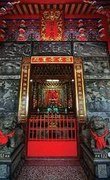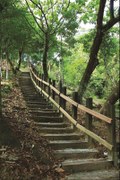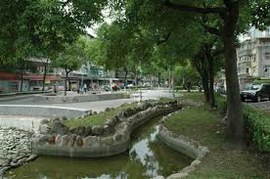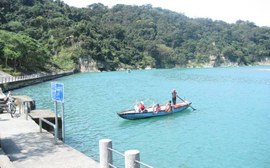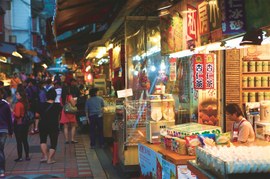Bitan -- The Glamorous East Bank
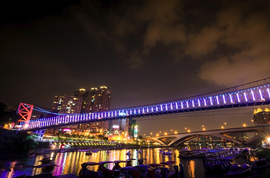
Bitan Suspension Bridge
The Glamorous East Bank
Xindian Bitan, once famed as one of the eight top landscapes in Taiwan, is renowned for it's charming landscape and jade green lake, which during the Japanese colonial period, attracted officials to take boats from Mengjia in order to appreciate it's riverside beauty. Bitan is divided by the Xindian Creek into the east bank and west bank, and joined by the Bitan Suspension Bridge that resembles a rainbow hanging above the creek, making it one of the landmarks of New Taipei City. The west bank features cliffs, hanging rocks, ancient temples and hiking trails, and is known as the "Little Red Cliff"; while the east bank is decorated with tourism facilities, biking path, fountains and restaurants, that draw large crowds, especially during weekends and holidays.
Bitan Suspension Bridge
The Bitan Suspension Bridge is a landmark in the happy memories of countless lovers who once walked across it hand-in-hand, overlooking the jade-like Bitan Lake under the sun, or the reflection of the colorful lights at night. The rainbow-like curve represents the irreplaceable beauty of the landscape. The 200m long bridge was completed in August 1936, and classified as one of the eight outstanding landscapes of Taiwan. Brightened by the changing colorful light beams, the bridge seems to reveal a different charm each night. The fishing stone tablet at the west-end of the bridge depicts the infinite recollections the Bridge has brought to generations of people. The tablet was inscribed by Lin Erjia of the renowned Lin Benyuan Family. Now, the bridge is highlighted by pearl-like light beams that highlight the unique gracefulness and allure of the ridge at night.
Xindian Old Street
The market of the Xindian Old Street on the east bank of the Bitan Suspension Bridge was set up back in the Qing Dynasty. It was once an important business hub connecting with the ports alongside the Xindian Creek in the great Taipei basin. Shops and food market accumulated here, making it a distribution center for the agricultural products of farmers from Wulai, Muzha, Jingmei and Ankeng. The drug stores, herbal shops, cake stores, hardware stores and grocery stores contributed to the human traffic of this bustling street. Although it's golden era has passed, one can still sense traces of it's old-time glamour nowadays.
Xindian Ferry Point
Back in the 1880s, before the public roads were paved, the citizens of Xindian who lived at the west bank around the Wantan, Zhitan, Tutan and Quchi regions had to rely on the ferry point to enter and exit the city. The human-powered ferry point is one of the prominent local features. Nowadays, people rarely take the ferry for transportation reasons, but rather to recapture the memories of the waterways taken by our ancestors, and also for enjoying the inviting lake scenery in the midst of the mountains.
Liugongzun Monument Water Park
Completed in 1754, the famous "Liugongzun" waterway construction of northern Taiwan turned the Great Taipei area from a drought stricken land into a fertile land. The construction laid down the foundation for the economic development of Taipei City. To commend the contribution of Guo Xiliu (Qing Dynasty) in the construction, and to record the hardship involved in digging the waterways, the monument was established in 1975 at the source of the waterway beneath the pier of the viaduct of National Highway 3. In addition to the epitaph, a water gate was also conserved, and the water park provided for the tourists to play.
Mt. Shitou (Lion Head Mountain Hiking Trail)
Bitan was formerly known as the Lion Head Lake due to the overlooking Mt. Shitou, or Lion Head Mountain. The mountain sits on the east bank of Bitan, with the highest point being the Changshou Pavilion at 223m. The mountain overlooks the entire Xindian,and entrances to hiking trails are available from the Zhongxing Rd., Wenzhong Rd., and Changchun Rd. The rich ecology and landscape of Mt. Shitou makes it a popular leisure and exercise spot of Xindian.
Kaitian Temple
Locating at the junction of Xindian Rd. and Xindianhou Rd., Kaitian Temple is a well-known ancient temple erected to calm the souls of folks due to the frequent slaughter of the craftsmen by the aboriginals during the early excavation of the Liugongzun waterfall, aw well as the noxious diseases experienced. The temple worships Pangu, the creator of the universe in Taoism. The original temple and the century-old banyan are long gone. The temple we see today is the new temple constructed in 1985. The famous Dapingin Stone Tunnel (the irrigation waterway of Liugongzun) is right below the temple.
Source of Article: Tourism and Travel Departement, New Taipei City Government.
| City | New Taipei City |
| Contact Information | Tourism and Travel Department, New Taipei City GovernmentTel: 02-29603456 Bitan Visitor CenterTel: 02-29131184 |
| Location | New Taipei City |
| Web Address | http://tour.ntpc.gov.tw/ |
| Transportation | BusG1,G3,G5,G6,G13,B7,642,644,647,650,839,930,1079 Sanhsia, 1602 Pinglin MRTGet off at Taipei Main Station and transfer onto the MRT Xindian Line. Get off at MRT Xindian Station and the Bitan Special Scenic Area is a 2 minute walk from Xindian Station Drive a carGet off National Highway 3 at Xindian Interchange that connects to Zhongxing Rd., turn right and continue for 2km to reach MAR Xindian Station. Public car parks: MRT Xindian Station underground car park&Bitan car park |
comments powered by Disqus

